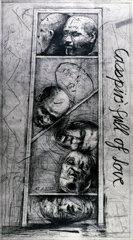William Kentridge
dal 8/2/2008 al 26/4/2008
Segnalato da
8/2/2008
William Kentridge
Williams College Museum of Art, Williamstown
Artist's prints represents over a third of the out put in the medium of printmaking for Kentridge, who deals in the tradition of socially and politically engaged artists. His work reflects on the human condition, specifically the history of apartheid in his own country and the ways in which our personal and collective histories are intertwined.

Williamstown, MA—The Williams College Museum of Art (WCMA) presents William Kentridge Prints, the first of a two-part exhibition, which features 120 works by this pioneering South-African artist. WCMA will also be showing Kentridge's film History of the Main Complaint, 1996, in the museum's media field gallery. Okwui Enwezor, Dean of Academic Affairs at San Francisco Art Institute and Adjunct Curator at International Center of Photography, New York, will give a lecture entitled "(Un) Civil Engineering: William Kentridge's Allegorical Landscapes" on Saturday, April 12 at 2:00 pm in Brooks -Rogers Recital Hall at Williams College. This is a free public program and all are invited to attend.
William Kentridge Prints represents over a third of the out put in the medium of printmaking for Kentridge, who works in the tradition of socially and politically engaged artists such as William Hogarth, Francisco Goya, Honore Daumier, and Kathe Kollwitz. Kentridge's work reflects on the human condition, specifically the history of apartheid in his own country and the ways in which our personal and collective histories are intertwined. The work in this exhibition ranges from 1976 to 2004 and includes aquatint, drypoint, engraving, etching, monoprint, linocut, lithograph, and silkscreen techniques, often in combinations. Kentridge's prints are rich in layering and restricted to black and white, with color accents added to selected images. The results are works that are powerful in the stark contrast of image to background in woodcuts and lithographs and subtle in linear and atmosphere with etching or monotypes.
“William Kentridge is one of the most innovative artists practicing today. His engagement with the profound political changes of his country have inspired a new generation of artists,” says Director Lisa Corrin.
History of the Main Complaint, 1996, a key animated film in Kentridge's oeuvre, will also be on view at WCMA this spring. His animated films are composed from his charcoal and pastel drawings, which he vigorously reworks, leaving traces of erasure and redrawing. Each stage is filmed and then animated. Traces of what has been erased are still visible to the viewer and as the films unfold a sense of fading memory or the passing of time. Through this process, Kentridge constructs moral allegories that explore themes of love and betrayal, oppression and violence, death and regeneration.
William Kentridge Prints was organized by Faulconer Gallery, Grinnell College, Grinnell, Iowa.
About the Artist
Born in Johannesburg, South Africa in 1955, Kentridge received a in Politics and African Studies at the University of the Witwatersrand and a diploma in Fine Arts from the Johannesburg Art Foundation. Between 1975 and 1991 he was acting and directing in Johannesburg’s Junction Avenue Theatre Company. In the 1980s he worked on television films and series as art director. He founded a theater company, studied mime and theater in Paris and, from 1982 to 1984, was art director for television series and feature films. In 1989, Kentridge began making short animated films by photographing his charcoal drawings with a video camera and altering them in minute ways to animate them. The political content and the unique techniques of Kentridges' work have propelled him into being one of South Africa’s most significant artists.
Programming
Lecture: (Un) Civil Engineering: William Kentridge's Allegorical Landscapes
Okwui Enwezor, Dean of Academic Affairs at San Francisco Art Institute and Adjunct Curator at International Center of Photography, New York.
Saturday, April 12
2:00 pm
Brooks-Rogers Recital Hall, Williams College
In this lecture, Okwui Enwezor will discuss the role of landscape as an archival structure of memory and narrative in the drawings, films, and tapestries within the context of post-apartheid culture. In addition Kentridge's work will be discussed in relation to his contemporaries, influences, and reaction to modes of work that seek to disremember the troubled relationship between cultures in South Africa.
Okwui Enwezor is Dean of Academic Affairs and Senior Vice President at San Francisco Art Institute. He was Artistic Director of Documenta 11, Kassel, Germany (1998–2002) and the 2nd Johannesburg Biennale (1996–1997). He has curated numerous exhibitions in some of the most distinguished museums around the world, including The Short Century: Independence and Liberation Movements in Africa, 1945–1994, which traveled internationally. He is founder and editor of the critical art journal Nka: Journal of Contemporary African Art published by the Africana Study Center, Cornell University. He has served on numerous juries, advisory bodies, and curatorial teams including: the advisory team of Carnegie International in 1999; Venice Biennale; Hugo Boss Prize, Guggenheim Museum; Foto Press, Barcelona; Carnegie Prize; International Center for Photography Infinity Awards; Young Palestinian Artist Award, Ramallah; and the Cairo, Istanbul, Sharjah, and Shanghai Biennales. Enwezor is the Artistic Director of Bienal Internacional de Arte Contemporaneo de Sevilla, in Seville, Spain. He lives in New York and San Francisco.
Williams College Museum of Art
Main Street in Williamstown, Massachusetts.
Tuesday through Saturday from 10 am-5 pm and Sunday from 1-5 pm.
Admission is Free



